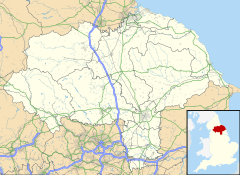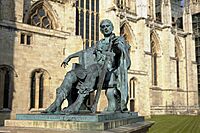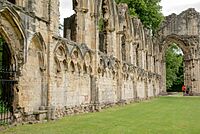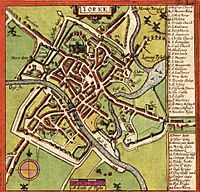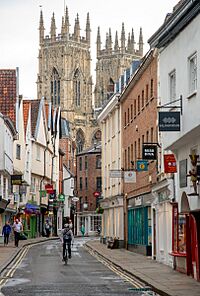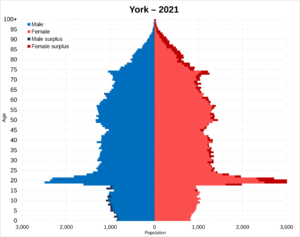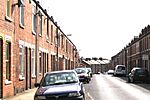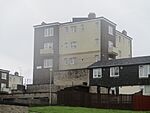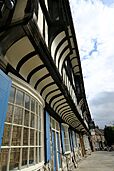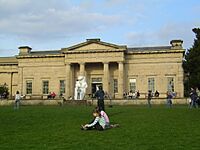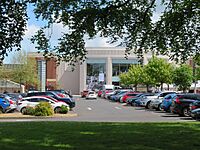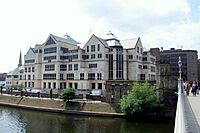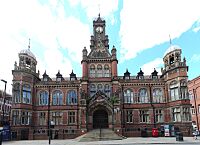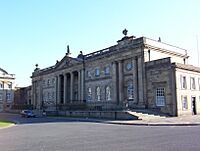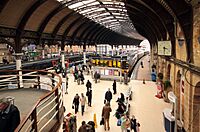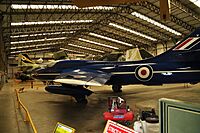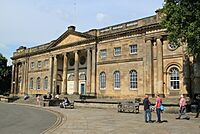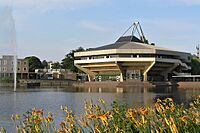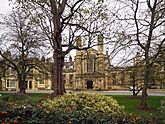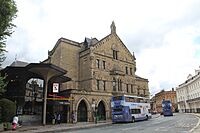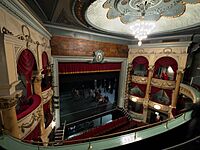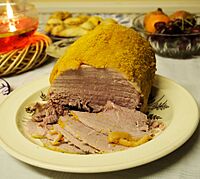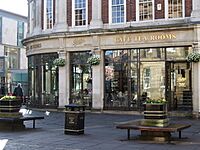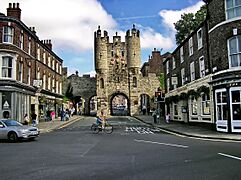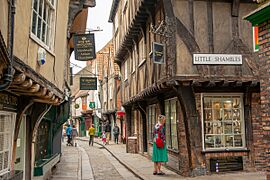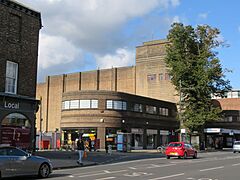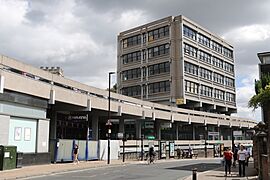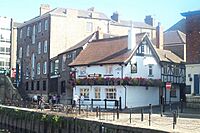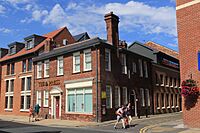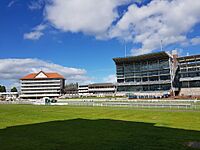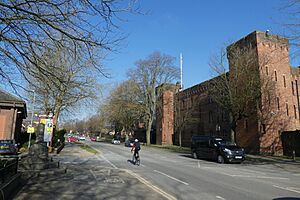York facts for kids
Quick facts for kids York |
|
|---|---|
| City | |
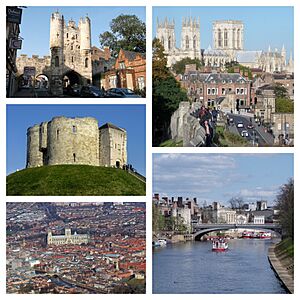 Clockwise from the top left: Micklegate Bar; York Minster from the city walls; Lendal Bridge; an aerial view of the city; and the castle |
|
| Area | 33.7 km2 (13.0 sq mi) |
| Population | 141,685 (2021 census) |
| • Density | 4,204/km2 (10,890/sq mi) |
| Unitary authority |
|
| Ceremonial county | |
| Region | |
| Country | England |
| Sovereign state | United Kingdom |
| Post town | YORK |
| Postcode district | YO1, YO10, YO19, YO23-24, YO26, YO30-32, YO41 |
| Dialling code | 01904 |
| Police | North Yorkshire |
| Fire | North Yorkshire |
| Ambulance | Yorkshire |
| EU Parliament | Yorkshire and the Humber |
York is a historic city in North Yorkshire, England. It sits where the River Ouse and River Foss meet. The city is famous for its many old buildings. These include a huge minster (a large church), a castle, and ancient city walls. York is the biggest town and main center of the wider City of York area. It is about 27 miles (43 km) northeast of Leeds. York's population was 141,685 in 2021.
The city began as Eboracum in 71 AD. It was once the capital of a Roman province. Later, it was the capital of kingdoms like Northumbria and Scandinavian York. In the Middle Ages, York became a key center for the church in northern England. It also grew as a place for trading wool. In the 1800s, York became a major railway hub. It also became known for making sweets. During the Second World War, parts of the city were bombed. Many historic buildings were damaged, and it took until the 1960s to fix them.
York has a unique history of local government. It was once a special area not part of the county's system. Since 1996, it has been governed by the City of York Council. This council also looks after nearby villages and rural areas.
Contents
- What's in a Name? York's History in Words
- York's Journey Through Time
- How York is Governed
- Exploring York's Geography
- Who Lives in York? Demographics
- York's Economy: How People Make a Living
- Public Services in York
- Getting Around York: Transport
- Learning in York: Education
- York's Culture and Fun
- Must-See Attractions in York
- Media in York
- Sports in York
- York's Military Presence
- York's Global Connections
- Honorary Citizens of York
- Famous People from York
- See also
What's in a Name? York's History in Words
The city's name comes from an old British word, Eburākon. This means "place of yew trees." The word eburos means "yew tree." Some think it could also mean "the property of Eburos," a Celtic person's name.
The Romans called it Eboracum or Eburacum. Later, in the 600s, the Angles changed it to Eoforwic. This name combined the old Ebor- with -wic, meaning "village." It might have been mixed up with a Germanic word for 'boar'.
When the Vikings took over in 866, they called it Jórvík. After the Normans arrived, the name slowly changed to York. The name "York" was first written down in the 1200s. Today, you can still see the Roman name in places like the Ebor race meeting. The Archbishop of York even signs his name as Ebor.
York's Journey Through Time
How York Began: Early History
People lived in the York area between 8000 and 7000 BC. But we don't know if they stayed there all the time. When the Romans arrived, the Brigantes tribe lived here.
The city of York was founded in 71 AD. The Roman Ninth Legion built a wooden fort near the River Ouse. Later, the VI legion rebuilt the fort walls in stone. This fort was huge, covering 50 acres (20 ha). It housed 6,000 Roman soldiers. You can still see parts of the Roman fort under York Minster today.
Important Roman Emperors like Hadrian and Septimius Severus visited York. Emperor Constantius I died in York in 306 AD. His son, Constantine the Great, was then made Emperor by the soldiers. In 314 AD, a bishop from York went to a big Christian meeting.
After 400 AD, York became less important. The population dropped due to floods. In the 5th century, the Angles took over.
York in the Middle Ages: Kings, Vikings, and Trade
In the 600s, King Edwin of Northumbria helped York grow again. He built the first wooden church in York in 627. This church was later rebuilt in stone. A famous scholar, Alcuin of York, taught at York's cathedral school. He later advised Charlemagne.
In 866, the Vikings attacked and captured York. They chose a holy day, All Saints' Day, to attack. Most of York's leaders were in the cathedral, so the city was not ready.
The Vikings renamed the city Jorvik. It became the capital of Viking lands in Britain. At its busiest, Jorvik had over 10,000 people. This made it the second-largest city in Great Britain after London. Jorvik was a key trading center for the Vikings. They made coins there. Archaeologists found workshops for making textiles, metalwork, and jewelry. Goods from far away, like the Persian Gulf, show Jorvik was part of a big international trade network. The last Viking ruler, Eric Bloodaxe, was forced out in 954 AD. This helped unite England.

After the Normans took over in 1066, the people of York rebelled. William the Conqueror put down the rebellion. He built two wooden castles. When another rebellion happened, he destroyed everything from York to Durham. The stone remains of these castles can still be seen today.
The first stone church was damaged by fire. So, the Normans built a new minster. Around 1080, Archbishop Thomas began building what is now York Minster.
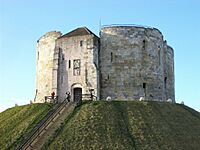
York began to do well in the 1100s. Sadly, in 1190, there was a terrible massacre of Jewish people at Clifford's Tower.
York became a major trading hub. This was thanks to its location on the River Ouse and the Great North Road. In 1212, King John gave York its first charter. This allowed the city to trade across England and Europe. York merchants imported wine from France and furs from the Baltic. They exported grain and wool.
York also became a big center for making and trading cloth. Edward I boosted the city's economy by using it as a base for his war in Scotland. York gained more independence from the government in 1396.
York from the 1500s to the 1700s
York's economy slowed down during the Tudor era. Under King Henry VIII, many monasteries in York were closed. This included St Mary's Abbey. This led to the Pilgrimage of Grace, an uprising by northern Catholics. Henry VIII then set up the Council of the North in York. The city became a center for trade and services. In 1541, King Henry VIII and Catherine Howard visited York. They stayed in St. Mary's Abbey, which had been turned into a palace.
Anne of Denmark visited York in 1603. Guy Fawkes, famous for the Gunpowder Plot, was born and went to school in York. He planned to blow up the Houses of Parliament.
In 1644, during the Civil War, Parliament's army surrounded York. Many old houses outside the city walls were destroyed. The city surrendered to Sir Thomas Fairfax on 15 July.
After the monarchy was restored in 1660, York changed. It became a social and cultural center for rich people in the north. Many grand houses and buildings like the Lord Mayor's Mansion House and Assembly Rooms were built then.
York in Modern Times
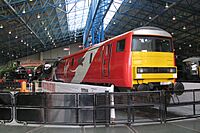
The railway came to York in 1839. This helped York become a major railway center by the late 1800s. The railways also brought engineering jobs to the city. By the early 1900s, the North Eastern Railway employed over 5,500 people.
The railway also helped Rowntree's Cocoa Works grow. It was started in 1862 by Henry Isaac Rowntree. His brother, Joseph, joined him later. Another chocolate maker, Terry's of York, was also a big employer. By 1900, railways and chocolate were York's two main industries.
York was also important for early photography. Many photographers had studios in the city in the 1800s.
In 1942, German planes bombed York during the Second World War. 92 people died, and many were hurt. Buildings like the Railway Station and Guildhall were damaged.

Tourism became very important for York. In 1968, the historic center was made a special conservation area. New attractions opened, like the National Railway Museum in 1975. The Jorvik Viking Centre opened in 1984, and the York Dungeon in 1986. The University of York opened in 1963, adding to the city's success. In 2012, York's Chocolate Story opened.
In 2007, York was named European Tourism City of the Year. In 2018, The Sunday Times called York the 'Best Place to Live' in Britain. They praised its "perfect mix of heritage and hi-tech."
How York is Governed
Local Government in York
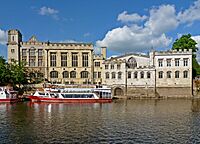
The City of York Council governs York. It handles all local services, like libraries and waste collection. The council has 47 councillors from 21 areas called wards. They serve for four years. The main offices are at the Guildhall.
The council is led by the Council Leader. This person leads the biggest political group. The current Council Leader is Cllr Keith Aspden from the Liberal Democrats.
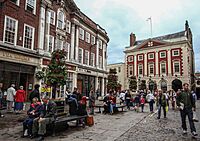
York's first citizen is the Lord Mayor. This person chairs council meetings and does ceremonial duties. The Lord Mayor is chosen each year in May. The Sheriff is also appointed at this time. These roles are mostly for show.
York also has a Youth Council. Young people work with councillors to improve things for kids in York.
In the 2023 election, the Labour Party won the most seats. They now run the council.
| Party | Seats | City of York Council (2023 election) | |||||||||||||||||||||||||||||||||||||||||||||||||
|---|---|---|---|---|---|---|---|---|---|---|---|---|---|---|---|---|---|---|---|---|---|---|---|---|---|---|---|---|---|---|---|---|---|---|---|---|---|---|---|---|---|---|---|---|---|---|---|---|---|---|---|
| Conservative | 3 | ||||||||||||||||||||||||||||||||||||||||||||||||||
| Independent | 1 | ||||||||||||||||||||||||||||||||||||||||||||||||||
| Labour | 24 | ||||||||||||||||||||||||||||||||||||||||||||||||||
| Liberal Democrat | 19 | ||||||||||||||||||||||||||||||||||||||||||||||||||
York's Parliament Representatives
Since 2010, York has two Members of Parliament (MPs). One represents York Central, the inner city area. The other represents York Outer, which surrounds the central area.
Ceremonial Role of York
York is part of the ceremonial county of North Yorkshire. The city still has the right to appoint its own Sheriff. The Duke of York has no official duties related to the city.
Exploring York's Geography
Where is York Located?
| Place | Distance | Direction | Relation |
|---|---|---|---|
| London | 280 km | South-east | Capital |
| Leeds | 35 km | South-west | Next nearest city |
York is in the Vale of York, a flat area with good farmland. It's surrounded by hills like the Pennines and North York Moors. The city was built where the Rivers Ouse and Foss meet. This spot was easy to defend in Roman times.

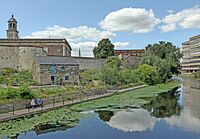
York can flood from the River Ouse. It has many flood defenses, including walls and a barrier. In 2000 and 2015, York had very bad floods. Much of the land around the city is prone to flooding.
York's Climate and Weather
York has a mild climate with four clear seasons. It's usually drier and warmer than other parts of Yorkshire. Winters can be cold with frost, fog, and winds. Snow can fall but usually melts quickly. Summers are often warmer than the coast, sometimes reaching 27 °C or more. The highest temperature recorded was 34.5 °C. The lowest was -16.3 °C.
| Climate data for RAF Linton-on-Ouse, 15 km north-west of York | |||||||||||||
|---|---|---|---|---|---|---|---|---|---|---|---|---|---|
| Month | Jan | Feb | Mar | Apr | May | Jun | Jul | Aug | Sep | Oct | Nov | Dec | Year |
| Record high °C (°F) | 16 (61) |
18 (64) |
22 (72) |
28 (82) |
30 (86) |
32 (90) |
40.2 (104.4) |
34 (93) |
32 (90) |
29 (84) |
20 (68) |
17 (63) |
40.2 (104.4) |
| Mean daily maximum °C (°F) | 7.0 (44.6) |
7.5 (45.5) |
10.0 (50.0) |
13.0 (55.4) |
16.6 (61.9) |
19.5 (67.1) |
22.0 (71.6) |
22.0 (71.6) |
18.4 (65.1) |
13.9 (57.0) |
9.7 (49.5) |
7.0 (44.6) |
14.0 (57.2) |
| Mean daily minimum °C (°F) | 2.0 (35.6) |
1.0 (33.8) |
2.4 (36.3) |
4.0 (39.2) |
6.7 (44.1) |
9.7 (49.5) |
11.8 (53.2) |
11.6 (52.9) |
9.5 (49.1) |
7.0 (44.6) |
4.0 (39.2) |
2.0 (35.6) |
6.0 (42.8) |
| Record low °C (°F) | −16 (3) |
−10 (14) |
−13 (9) |
−3 (27) |
1 (34) |
2 (36) |
5 (41) |
5 (41) |
−1 (30) |
−4 (25) |
−8 (18) |
−16 (3) |
−16 (3) |
| Average precipitation mm (inches) | 52.7 (2.07) |
39.9 (1.57) |
44.9 (1.77) |
50.1 (1.97) |
43.8 (1.72) |
58.0 (2.28) |
53.2 (2.09) |
62.4 (2.46) |
46.9 (1.85) |
57.7 (2.27) |
57.8 (2.28) |
55.8 (2.20) |
626.0 (24.65) |
| Average precipitation days | 11.1 | 9.1 | 9.5 | 9.3 | 9.1 | 9.3 | 8.9 | 10.0 | 8.6 | 10.4 | 11.3 | 10.7 | 117.2 |
| Mean monthly sunshine hours | 40 | 60 | 100 | 141 | 190 | 220 | 230 | 205 | 156 | 105 | 65 | 47 | 1,550 |
| Source 1: Met Office | |||||||||||||
| Source 2: BBC Weather | |||||||||||||
York's Green Spaces
York has a "green belt" around its urban areas. This protects the countryside and keeps the city's historic feel. It stops too much building in rural areas.
Who Lives in York? Demographics
In 2011, York's urban area had 153,717 people. The wider City of York area had 198,051 people. Most residents (94.3%) were White. About 3.4% were Asian, and 0.6% were Black. In 2019, the city's population was estimated at 210,620.
How York's Population Has Changed
| Population growth in York since 1801 | |||||||||||||||||||||||
|---|---|---|---|---|---|---|---|---|---|---|---|---|---|---|---|---|---|---|---|---|---|---|---|
| Year | 1801 | 1811 | 1821 | 1831 | 1841 | 1851 | 1861 | 1871 | 1881 | 1891 | 1901 | 1911 | 1921 | 1931 | 1941 | 1951 | 1961 | 1971 | 1981 | 1991 | 2001 | 2011 | |
| Population | 24,080 | 27,486 | 30,913 | 36,340 | 40,337 | 49,899 | 58,632 | 67,364 | 76,097 | 81,802 | 90,665 | 100,487 | 106,278 | 112,402 | 123,227 | 135,093 | 144,585 | 154,749 | 158,170 | 172,847 | 181,131 | 198,051 | |
| Source: Vision of Britain | |||||||||||||||||||||||
Different Backgrounds in York
York is home to people from many different backgrounds.
| Ethnic Group | Year | |||||||
|---|---|---|---|---|---|---|---|---|
| 1991 | 2001 | 2011 | 2021 | |||||
| Number | % | Number | % | Number | % | Number | % | |
| White: Total | 165,118 | 99% | 177,191 | 97.8% | 186,731 | 94.2% | 188,167 | 92.8% |
| White: British | – | – | 172,237 | 95.1% | 178,613 | 90.1% | 176,963 | 87.3% |
| White: Irish | – | – | 1,217 | 1,103 | 1,317 | 0.6% | ||
| White: Gypsy or Irish Traveller | – | – | 269 | 368 | 0.2% | |||
| White: Roma | 222 | 0.1% | ||||||
| White: Other | – | – | 3,737 | 6,746 | 9,297 | 4.6% | ||
| Asian or Asian British: Total | 952 | 0.6% | 2,027 | 1.1% | 6,740 | 3.4% | 7,634 | 3.8% |
| Asian or Asian British: Indian | 237 | 542 | 1,531 | 1,853 | 0.9% | |||
| Asian or Asian British: Pakistani | 68 | 201 | 417 | 545 | 0.3% | |||
| Asian or Asian British: Bangladeshi | 133 | 364 | 370 | 413 | 0.2% | |||
| Asian or Asian British: Chinese | 318 | 642 | 2,449 | 2,889 | 1.4% | |||
| Asian or Asian British: Other Asian | 196 | 278 | 1,973 | 1,934 | 1.0% | |||
| Black or Black British: Total | 304 | 0.2% | 341 | 0.2% | 1,194 | 0.6% | 1,325 | 0.7% |
| Black or Black British: African | 113 | 164 | 903 | 978 | 0.5% | |||
| Black or Black British: Caribbean | 104 | 143 | 205 | 208 | 0.1% | |||
| Black or Black British: Other Black | 87 | 34 | 86 | 139 | 0.1% | |||
| Mixed or British Mixed: Total | – | – | 1,144 | 0.6% | 2,410 | 1.2% | 3,741 | 1.8% |
| Mixed: White and Black Caribbean | – | – | 248 | 529 | 631 | 0.3% | ||
| Mixed: White and Black African | – | – | 114 | 305 | 494 | 0.2% | ||
| Mixed: White and Asian | – | – | 456 | 873 | 1,579 | 0.8% | ||
| Mixed: Other Mixed | – | – | 326 | 703 | 1,037 | 0.5% | ||
| Other: Total | 439 | 0.2% | 973 | 1,954 | 1% | |||
| Other: Arab | – | – | 498 | 623 | 0.3% | |||
| Other: Any other ethnic group | 439 | 0.2% !! 391 | 475 | 1,331 | 0.7% | |||
| Total | 166,813 | 100% | 181,094 | 100% | 198,051 | 100% | 202,821 | 100% |
Religious Beliefs in York
Most people in York are Christian. In 2011, 59.5% of residents said they were Christian. The number of people with "No Religion" is higher than the national average.
York has many churches, mostly from the medieval period. York Minster is the main church for the Church of England in northern England.
York also has eight Roman Catholic churches. Leaders from different Christian groups work together in York. There are also meeting places for Quakers, Methodists, and Unitarians. York has a Mosque and a UK Islamic Mission center. Buddhist groups and an active Jewish community are also present.
| Religion | 2001 | 2011 | 2021 | |||
|---|---|---|---|---|---|---|
| Number | % | Number | % | Number | % | |
| No religion | 30,003 | 16.6 | 59,646 | 30.1 | 93,577 | 46.1 |
| Holds religious beliefs | 137,377 | 75.9 | 123,009 | 62.1 | 95,314 | 47.0 |
| 134,771 | 74.4 | 117,856 | 59.5 | 89,019 | 43.9 | |
| 388 | 0.2 | 1,016 | 0.5 | 1,045 | 0.5 | |
| 347 | 0.2 | 983 | 0.5 | 1,043 | 0.5 | |
| 191 | 0.1 | 202 | 0.1 | 273 | 0.1 | |
| 1,047 | 0.6 | 2,072 | 1.0 | 2,488 | 1.2 | |
| 95 | 0.1 | 133 | 0.1 | 179 | 0.1 | |
| Other religion | 538 | 0.3 | 747 | 0.4 | 1,266 | 0.6 |
| Religion not stated | 13,714 | 7.6 | 15,396 | 7.8 | 13,930 | 6.9 |
| Total population | 181,094 | 100.0 | 198,051 | 100.0 | 202,821 | 100.0 |
York's Economy: How People Make a Living
Understanding York's Economy
York's economy is worth £5.2 billion to the UK. It has 9,000 businesses and 110,000 jobs. The city has a skilled workforce and good transport links.
Most jobs in York are in the service industry. This includes public services, health, education, and tourism. Tourism is a very important part of York's economy. The city has many historic places to visit, like York Minster. In 2019, tourism brought in over £765 million. It supported 24,000 jobs and attracted 8.4 million visitors.
Unemployment in York was low in 2008. The biggest employer is the City of York Council. Other large employers include Aviva, Network Rail, and the University of York.
In the past, York's economy relied on chocolate making and railways. The York Carriage Works once employed 5,500 people but closed in the 1990s. Today, York is home to Nestlé York (formerly Rowntree's). They make famous chocolates like KitKat and Yorkie. Terry's chocolate factory used to be in York but closed in 2005.
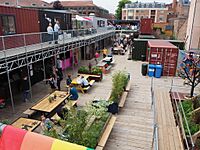
York's economy is now growing in science, technology, and creative industries. The city has a science park near the University of York. Between 1998 and 2008, York gained 80 new technology companies.
How COVID-19 Affected York's Economy
The COVID-19 pandemic caused an economic slowdown in York. Businesses and travel faced restrictions. By January 2021, unemployment rose. The retail, hospitality, and tourism sectors were hit hard.
In August 2020, "Make It York" and the city council started a plan. They wanted to help the city recover and build confidence. Some thought York relied too much on tourism. However, experts believed York was ready to bounce back. They thought new businesses would focus on experiences. They also predicted more "staycation" trips to York.
Public Services in York
The North Yorkshire Police provides policing in York. The North Yorkshire Fire and Rescue Service handles fire and rescue.
York's main hospital is York Hospital. It opened in 1976 and provides general healthcare. The Yorkshire Ambulance Service provides ambulance services.
Yorkshire Water manages York's drinking water and wastewater.
York has a magistrates' court and a Crown Court. The York Crown Court building was designed by John Carr. The old prison is now the Castle Museum.
Getting Around York: Transport
Waterways in York
York's location on the River Ouse and Foss has always been important for transport. The Ouse used to be tidal, allowing ships to reach York. Today, both rivers are still navigable. A lock at Naburn stops the Ouse from being tidal in York.
In the past, barges carried goods between York and Hull. Now, the rivers are mostly used for leisure boats.
Roads Connecting York
York is well-connected by major roads. The A19 road, A59 road, A64 road, and A1079 road all meet here. The A64 links York to the A1(M) and M1 motorways. The M62 motorway is also nearby.
An outer ring road goes around the city. This helps traffic avoid the city center. Many streets inside the city walls are for pedestrians only. York also has six park and ride sites. Visitors can park outside the city and take a bus into the center.
Buses in York

Buses are the main public transport in York. First York runs most local services and park and ride buses. Transdev York also runs many local routes. Open-top tourist buses are available for sightseeing.
Buses also connect York to nearby towns and villages. Longer-distance services go to places like Hull and Harrogate.
Railway Connections in York
York has been a major railway center since 1839. It was once the headquarters for the North Eastern Railway.
York railway station is a key stop on the East Coast Main Line. Five train companies serve York.
| Point A | Via | Point B | Via |
|---|---|---|---|
| London North Eastern Railway | |||
| London King's Cross (under two hours from York, around 25 direct trains each weekday) | Peterborough & Doncaster | Edinburgh Waverley | Durham & Newcastle |
| Sunderland | |||
| Middlesbrough | Thornaby | ||
| CrossCountry | |||
| Plymouth | Bristol Temple Meads, Birmingham New Street, Derby, Sheffield & Wakefield Westgate | Glasgow Central & or Edinburgh Waverley | Darlington, Durham & Newcastle |
| Newcastle | Durham & Darlington | Southampton Central & or Reading | Birmingham International, Birmingham New Street & Oxford |
| TransPennine Express | |||
| Newcastle | Darlington | Liverpool Lime Street | Leeds, Dewsbury, Huddersfield & Manchester Victoria |
| Redcar Central | Middlesbrough | Manchester Airport | Huddersfield, Manchester Oxford Road & Manchester Piccadilly |
| York | Terminus | Scarborough | Malton & Seamer |
| Northern | |||
| York (the provider's headquarters) | Terminus | Leeds | Harrogate |
| Bridlington | Hull Paragon | ||
| Sheffield | Rotherham Central | ||
| Blackpool North | Bradford Interchange, Halifax, Hebden Bridge, Burnley Manchester Road, Blackburn & Preston | ||
| Grand Central | |||
| London King's Cross | Peterborough | Sunderland | Eaglescliffe & Hartlepool |
Air Travel from York
The closest international airports are Leeds Bradford (30 miles/48 km away) and Teesside (47 miles/76 km). Manchester (84 miles/135 km) offers flights to Europe, North America, Africa, and Asia. It has direct train links to York.
York has an airfield at the former RAF Elvington. This is home to the Yorkshire Air Museum.
Learning in York: Education
Museums and Historic Buildings in York
York Castle includes the medieval Clifford's Tower and the York Castle Museum. The city has many other museums and historic sites. These include the Yorkshire Museum, Jorvik Viking Centre, and York Art Gallery. You can also visit Merchant Adventurers' Hall and Fairfax House.
The National Railway Museum is near the station. It has a huge collection of trains, including the famous Mallard and Flying Scotsman. You can also visit the York Cold War Bunker to learn about the Cold War.
York's first public library opened in 1893. The current York Library building opened in 1927.
Universities and Colleges in York
The main campus of the University of York is on the edge of the city. Some of its departments are in the historic King's Manor in the city center.
York St John University also has university status. It used to be a college of the University of Leeds. The Hull York Medical School is also part of the University of York.
York has two main colleges for further education. York College offers many academic and vocational courses. Askham Bryan College specializes in subjects like horticulture and agriculture.
Schools in York
There are 70 local council schools in York. They teach over 24,000 students. Primary schools teach ages 5–11. Ten secondary schools teach ages 11–16. Four of these also offer education up to age 18.
All Saints School is an "outstanding" Roman Catholic secondary school. It was founded in 1665. It's the only Catholic secondary school in the city.
York also has several private schools. St Peter's School was founded in 627. The famous scholar Alcuin taught there. Guy Fawkes also went to this school.
Two schools, Bootham School and The Mount School, have Quaker origins. Bootham is for both boys and girls. The Mount School is for girls only. Queen Margaret's School is another all-girls school.
York's Culture and Fun
York is part of the UNESCO Creative Cities Network for its media arts.
Theatre and Plays in York
The Theatre Royal opened in 1744. It puts on a popular annual pantomime. The Grand Opera House and Joseph Rowntree Theatre also have many shows. York is home to the Riding Lights Theatre Company.
The York Mystery Plays are performed regularly. These plays are based on old medieval stories. They were first performed in the 1300s. Famous actors like Dame Judi Dench have been in them.
Music Scene in York
The Academy of St Olave's is a music group that performs in St Olave's Church. The National Centre for Early Music is in a former church. It hosts concerts and events, including the York Early Music Festival. Students and staff from the York St John University and University of York music departments also perform.
Food and Drink in York
Every September, York holds a Festival of Food and Drink. It highlights local food from York and North Yorkshire. The festival attracts many visitors.
The Assize of Ale is an old tradition in York. People in medieval costumes visit pubs to raise money for charity. It started in the 1200s to check the quality of beer.
York's racecourse hosts Yorkshire's biggest beer festival. It offers hundreds of different beers and ciders.
A local food is York ham. It's a mild, pink ham. Some say the sawdust from building York Minster was used to smoke it.
Tea Rooms in York
In the center of York, you'll find Bettys Café Tea Rooms. The founder was so impressed by the Queen Mary ship. He hired its designers to create the elegant café. During World War II, the basement "Bettys Bar" was popular with airmen. Many of them carved their names on "Bettys Mirror."
Must-See Attractions in York
York's Amazing Architecture
York Minster, a huge Gothic cathedral, is the most famous building.
York's center is surrounded by its medieval walls. These are the most complete in England. You can walk along them. They include parts of Roman and Norman walls. The full walk is about 2.5 miles (4 km).
The Snickelways are narrow walking paths in central York. Many led to old market places. The Shambles is a narrow medieval street. It's full of shops and tea rooms. Its name comes from an old word for a meat market. You can still see hooks where meat was hung.
-
The Shambles is a medieval shopping street; most of the buildings date from between c. 1350 and 1475.
-
The Art Deco style Odeon Cinema on Blossom Street
-
The 1960s Brutalist-style Stonebow House
York's Pubs
In 2015, York had over 100 pubs in its city center. Some are hundreds of years old. Famous ones include the Golden Fleece and Ye Olde Starre Inne. The Kings Arms is often photographed during floods. York is known as a top UK beer destination.
Media in York
York has a local newspaper, The Press. There are also four local radio stations: BBC Radio York, YorkMix Radio, YO1 Radio and Jorvik Radio. YorkMix is a digital news and radio website.
Local TV news comes from BBC Yorkshire and ITV Yorkshire. York also has its own local TV channel, That's TV North Yorkshire.
The University of York has its own TV station, York Student Television (YSTV). It also has two campus newspapers and a radio station, URY.
Sports in York
Football in York
York's football team is York City. They are known for beating bigger teams in cup competitions. They reached the FA Cup semi-final in 1955. They beat Manchester United 3–0 in 1995. Their home ground is the York Community Stadium. Famous footballers from York include Lucy Staniforth and Lewis Cook.
York also has a strong rugby league history. The York Wasps were one of the oldest rugby league clubs. After they went bankrupt, supporters formed a new club, York City Knights. They also play at the York Community Stadium. The men's team is now called York Knights, and the women's team is York Valkyrie.
Rugby Union in York
Rugby union has been played in York since the 1860s. York RUFC was formed in 1928. Their home ground is at Clifton Park. Other teams include York Railway Institute (RI) RUFC and Nestle Rowntree RUFC.
Field Hockey in York
York has several field hockey clubs. These include City of York Hockey Club, Acomb Hockey Club, and University of York Hockey Club.
Horse Racing in York
York Racecourse started in 1731. It's a major horseracing venue. Thousands of people come to York each year for the 15 race meetings. The racecourse also hosted Royal Ascot in 2005. The four-day Ebor Festival is held in August.
In 2014, York hosted the start of Stage 2 of the 2014 Tour de France. In 2015, the first Tour de Yorkshire race finished in York.
Other Sports in York
An open rowing club, York City Rowing Club, is under Lendal Bridge. University rowing clubs also use the River Ouse. There are two sailing clubs near York.
York hosts the UK Snooker Championship at the York Barbican.
York's Military Presence
York Garrison is a base for the British army. It has several units in and around the city. These include:
- York Station
- Imphal Barracks
- Headquarters, 1st (United Kingdom) Division
- 2 Signal Regiment
- Worsley Barracks
- Helmand Company, 4th Battalion, Royal Yorkshire Regiment
- Yeomanry Barracks
- A (Yorkshire Yeomanry) Squadron, Queen's Own Yeomanry
- Imphal Barracks
- Strensall Station
- Queen Elizabeth Barracks
- Headquarters, 2nd Medical Brigade
- 34 Field Hospital, Royal Army Medical Corps
- Queen Elizabeth Barracks
York's Global Connections
Twin Towns and Sister Cities
York is connected with other cities around the world:
In 2016, York became a sister city with Nanjing, China. They agreed to build links in tourism, education, and culture.
In 2014, York also had a "temporal twinning" with Jórvík. This was the Viking city that stood on York's site from 866 to 1066. In 2017, York became the UK's first "human rights city." This means the city aims to use human rights in its decisions.
Honorary Citizens of York
Individuals Given Freedom of the City
The "Freedom of the City" is a special honor given to people.
- John Kendal: 1482.
- John Moore: 1687.
- Cosmo Gordon Lang: 1928.
- Mary, Princess Royal and Countess of Harewood: 1952.
- Edna Annie Crichton: 1955.
- Sarah, Duchess of York: 1987.
- Katharine, Duchess of Kent: 1989.
- John Barry: 2002.
- Dame Judi Dench: 2002.
- Berwick Kaler: 2003.
- Professor Sir Ronald Cooke: 2006.
- Neal Guppy: 2010.
Military Units Given Freedom of the City
- The Royal Dragoon Guards: 1999.
- 2 Signals Regiment: 2001.
- A Squadron The Queen's Own Yeomanry: 2009.
- RAF Linton on Ouse: 2010.
- The Queen's Gurkha Signals: 2015.
Famous People from York
See also
 In Spanish: York para niños
In Spanish: York para niños


